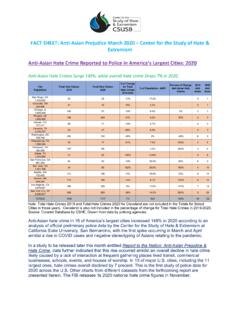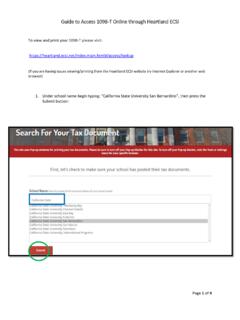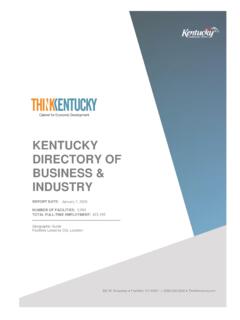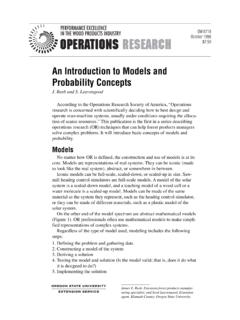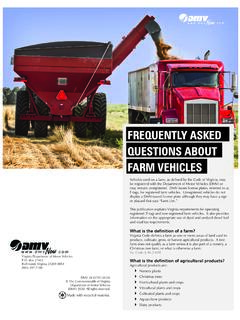Transcription of Lesson 1: Natural, Human, and Capital Resources
1 Standard Economic Resources and Choices 1 Lesson 1: Natural, Human, and Capital Resources Focus Question: How are natural Resources , human Resources and Capital Resources used to produce goods and services? Activity # 1 Identifying Resources Used in Long Tome Ago Note: This activity aims to develop an understanding of natural, human, and Capital Resources through a mapping exercise. The Communityville Lesson has been adapted from The Community Publishing Company by Diane Wilcox Reinke, published by the Joint Council on Economic Education.
2 The activity is an extension of the Communityville Lesson found in the Grade 3 Unit 1, Lesson 5. Materials needed: For each pair of students, a copy of Long Time Ago (Handout # ) vocabulary word cards for: natural Resources , human Resources , Capital Resources , goods, and services. (Definitions are included in the Lesson on page 5.); magnifying glasses; document camera or make a transparency of the 3 handouts. Procedure: Step 1: It is helpful to discuss one quadrant at a time of the map Long Time Ago (Handout # ).
3 Have students fold each map vertically and then horizontally. Label the upper left-hand quadrant A1 and the right-hand quadrant B1. Label the lower quadrants A2 and B2 respectively. Using a magnifying glass, have students examine the map. Note the major symbols (trees, rivers, buildings, streets, the lake, railroad, ). As the items are discussed, develop the following table on chart paper or on the board: Continuity and Change Before People Came to After People Came to Live in Communityville Live in Communityville trees buildings river roads land railroad Ask students: What symbols would have been found on a map of the Communityville area before people lived there?
4 ( , trees and river). What symbols would be found on a map of San Diego before people lived here? Explain to the students that they have been listing Resources . The items listed on the chart before people came to live in Communityville or to San Diego are called natural Resources . What symbols do you find on the map after people have come to live in Communityville? ( , buildings, roads, and railroad)? What symbols would be found on a map of San Diego now that people live here? Step 2: Display vocabulary cards for the following terms: Natural Resources are something from nature that people can use, such as trees, land, water, animals, and minerals, Standard Economic Resources and Choices 2 Human Resources are the people needed to grow or make and sell a product or service.
5 The people who came to live in Communityville used their human Resources (their labor) along with the natural Resources , to build the roads, railroad, and buildings, Capital Resources include money to start a new business, tools, buildings, machinery, and any other goods people make to produce goods and provide services. The items the people in Communityville produced are called Capital Resources . Step 3: Ask students questions such as: How did the people of Communityville use the natural Resources to make the things they wanted?
6 (They used trees to build buildings and bridges, They used water for drinking, cleaning and transportation, They used the land for growing crops and feeding animals, ) How did the local Kumeyyay Indians use natural Resources for the things they wanted? What Capital Resources did the people use when building Communityville? (Plows, axes, wagons, saws, and machines, ) Step 4: Explain that there are places on the map where the people of the community can buy things such as food, education, shelter, medical care, and clothing.
7 These are generally classified as goods or services. Display the following vocabulary cards: Goods are products or things that can be bought or sold. Services are the work that people do for others in exchange for money. For example, a piece of clothing is a good, and the work involved in making it is a service. The food you buy in a restaurant is a good, but you have also bought the services of the following people: the cook; the person who served the food; the cashier who took your payment; and, the kitchen helper who cleaned up after you left.
8 Step 5: Return to the Communityville map. Locate, circle, and label some places on the map where people in Communityville can buy goods and/or services. Write G for the word good and write S for the word service. Ask How can we indicate something that fits both categories? (write both letters) Guide to Goods and Services for the Map of Long Time Ago sawmill good (wood) Post Office service (delivers mail) House of Worship service ( , marriage, funerals and consultation) Farm good (food) School service (education) Police Station service (protection) City Hall service (government) Fire Station service (protection) Bank service (savings accounts and loans) General Store goods ( , food, soap, and newspapers) Doctor s House service (medical care) Caf good (food)
9 And service (cooking and serving food) Railroad Station service (transportation) Town Dump service (a holding place for garbage) Standard Economic Resources and Choices 3 Explain to students that Resources are used to produce goods and services that people want. Consequently, when the wants of people change or when there is a change in the Resources available, the community changes or adapts to meet the new wants. Activity # 2 Materials needed: For each pair of students, a copy of (Handout # ) Procedure: Step 1: Project a copy of (Handout # ) and distribute copies to the students.
10 Have students analyze how the community has grown as they compare and contrast the changes between this map and the map of Communityville A Long Time Ago. Step 2: On a sheet of chart paper or on the board, copy the table shown below and list changes as the class discovers them. Ask what natural Resources and Capital Resources have changed. Natural Resources That Have Changed Capital Resources That are New or Have Changed Trees removed by the enlargement of the sawmill , school, caf , fire station Bridge built over river Lake dried and lowland now exists Ball park added next to school Oil discovered Buildings added such as library, hardware store, hotel, and gas station Small road to cabin removed Oil well constructed Buildings enlarged such as the sawmill (trees removed) caf (now a restaurant), and fire station (trees removed) Ask students.



